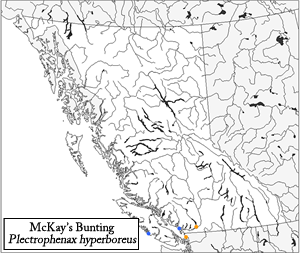Breeding male
This unmistakable plumage is held between March and August and is unlikely to be encountered in B.C. The plumage is almost entirely pure-white, with the exception of black tips to the central tail feathers, black tips to the primaries, and black tertials; most birds also show variable amounts of black on the scapulars. The iris is dark, the short, conical bill is black, and the legs and feet are black.
Non-breeding male
This plumage is held between August and March. It is overall similar to the plumage of the breeding male, but the head and upperparts are faintly washed with rusty-buff or brownish-buff (darkest and most prominent on the crown, ear coverts, and sides of the breast). The bill is yellowish, but bare part colouration is otherwise similar to that of the breeding plumage.
Breeding female
This plumage is held between March and August and, like in the male, is unlikely to be encountered in British Columbia. The plumage is similar to that of the breeding male, but the back and scapulars are variably streaked with black, the tail and wings show more extensive black (white patch on wings largely restricted to the upper secondary coverts, secondaries, and bases of the inner primaries), and the forehead, crown, and ear coverts show variable amounts of fine, blackish speckling. In addition, there is sometimes a very faint buffy or brownish tinge on the head, upperparts, and upperwings (although many birds lack this and appear more or less black and white). Bare part colouration is similar to the breeding male.
Non-breeding female
This plumage is held between August and March. Non-breeding females resemble breeding-plumaged females, but have less noticeable black streaking on the upperparts (largely obscured by extensive whitish feather edges), a brownish tinge to the black areas of the plumage, a yellow bill, and a stronger buffy or rusty-buff wash on the head and upperparts which, like the male, is darkest and most prominent on the crown, ear coverts, and sides of the breast.
First-winter immature
Immature plumage is held throughout the first winter, being lost during the early spring (March-April) of the second year. This plumage of both sexes is similar to the non-breeding female, but shows considerably more buffy or rusty-buff on the head and upperparts (especially on the crown, ear coverts, sides of the breast, scapulars, and tertial fringes), often with a buffy wash over the rump. The white areas of the wings and tail are slightly less extensive than in the adult female, particularly in the immature female (immature male approaches adult female in this characteristic).
Measurements
Total Length: 16.5-17 cm
Mass: 42-44 g
Source: Lyon and Montgomerie (1995b); Sibley (2000)

